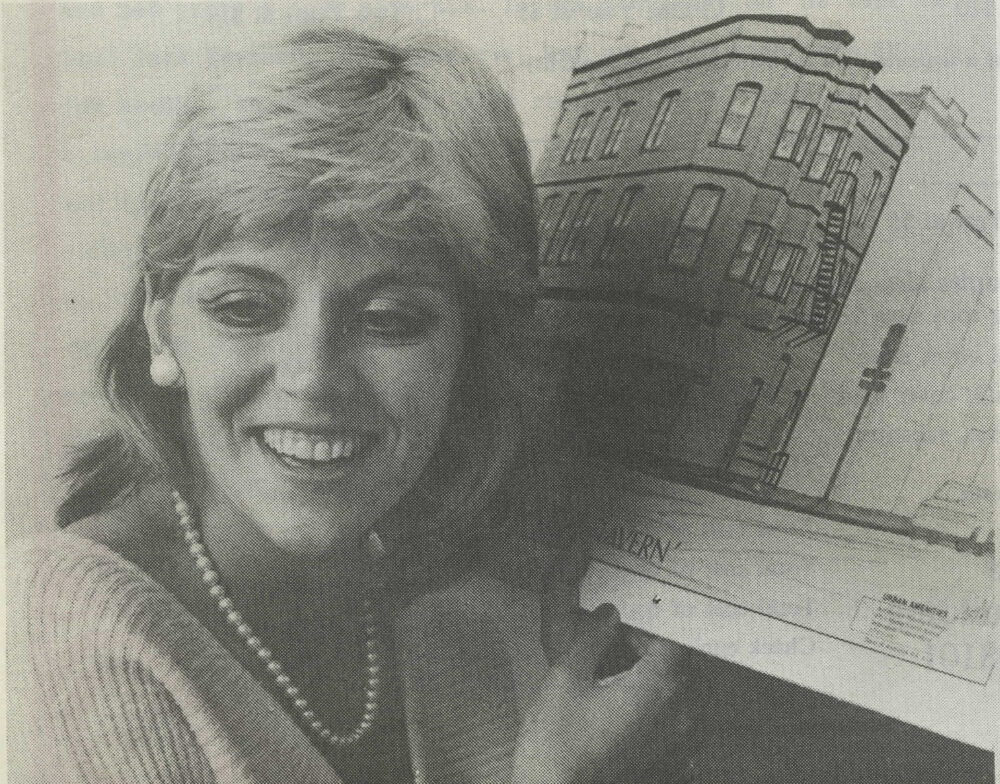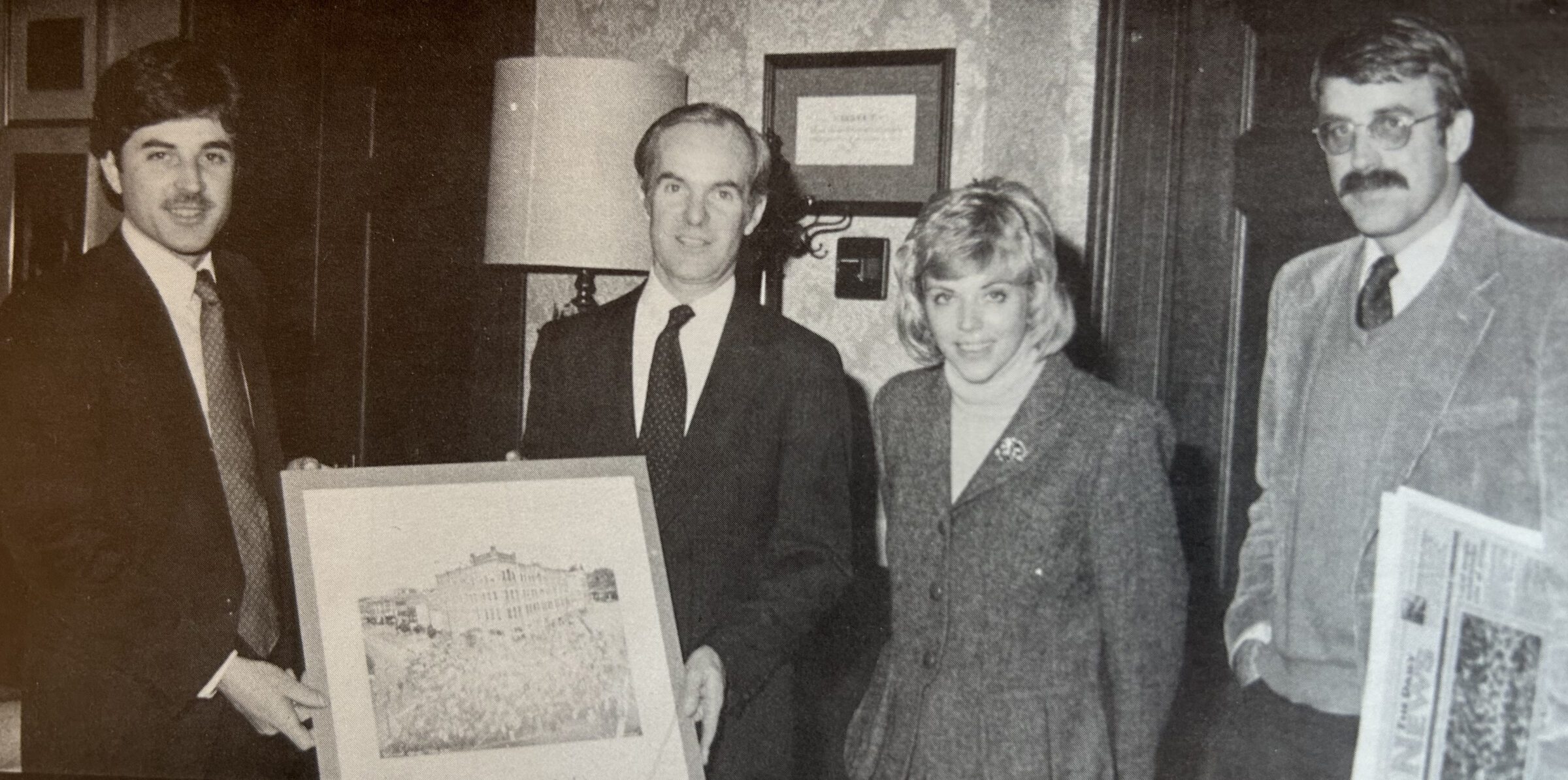“Let Me Tell You About Main Street”: An Interview with Washington State Main Street Program Founder Mary Thompson

By Breanne Durham, Washington State Main Street Program Director
Above: Mary (née King) Thompson pictured in 1984 upon her transition from Indiana to Washington. Photo courtesy of Indiana Landmarks.
Not too long after Washington’s gubernatorial election in 1984, a young Mary Thompson (née King) found herself in an elevator in Olympia with Governor-Elect Booth Gardner. Mary had recently moved to Washington to launch the state’s Main Street program. Upon seeing Gardner enter the elevator, Mary said, “You’re the new governor! Let me tell you about Main Street…” Some minutes later, when Gardner reached his meeting on the 5th floor and a department head brought up the state’s brand-new Main Street program, Gardner cut him off: “That’s okay. I’ve just been briefed.”
Well, let me tell you about (Washington) Main Street—specifically about how this scrappy little program got started. Hold onto your seats, though, because it’s not just an origin story. It’s also a political drama and (quite seriously) a love story.
But let’s start at the beginning: 1984 was a big year for Main Street nationwide. Mary Means, the founder of the movement, had recently hosted a national video conference, a five-hour, live-televised event that attracted more than 30,000 viewers around the nation who were interested in this new approach to saving their towns. In Washington State, participants included Garry Schalliol of the Washington Trust for Historic Preservation, State Historic Preservation Officer Jake Thomas, and Eric Hovey from the City of Vancouver and the Washington Downtown Association. Mary credits these three men with taking the germ of an idea to start a statewide Main Street program to the legislature that year to ask for funding.
However, the spring of 1984 was a short legislative session, and sine die was quickly upon them. At 10 minutes to midnight, with all legislators anxious to wrap up budget negotiations, Senator Al Williams of Olympia submitted an amendment to fund the state’s first-ever Main Street program. With funding secured, the Washington State Main Street Program would launch later that year. But the last-minute move had earned the program a powerful enemy in Representative Dan Grimm of Puyallup, Chair of House Appropriations, who felt that his carefully constructed budget had been sabotaged.
The program’s champions knew they had to move fast to prove Main Street’s value before the next state budget cycle. It was determined that the program would be housed by the Washington Trust for Historic Preservation, and then-executive director Schalliol reached out to a former employee of his, Mary King, asking her to apply. Mary was in Indianapolis, working for the Riley Area Revitalization Program, and had several prospects for her next career move. With a friend’s advice that “young people have a greater opportunity to make a difference out west,” Mary accepted the job as the Washington State Main Street Program’s first program coordinator.

Photo source unknown.
Upon arrival, Mary was tasked with reviewing applications for the Washington State Main Street Program’s five pilot communities: Port Townsend, Centralia, Pullman, Olympia, and Longview. Walla Walla was not initially selected, but the town was persistent in seeking Mary’s help to quickly build their capacity and joined the young network as its sixth community the following year.
When Mary wasn’t traveling across the state to support the pilot communities, she found herself with a desk in the Department of Community Development. Mary’s decision to situate herself in Olympia was part of a strategy to work alongside peer programs and build support for Main Street’s future. Around the same time, Governor Gardner appointed Dick Thompson of Puyallup to be the director of the Department of Community Development. As he settled in to his new office, Dick asked, “What’s this woman doing downstairs?” (Some years later, after Mary had transitioned to a role at the National Main Street Center, she and Dick started dating, and the rest is history.)
While he was perplexed by the woman in the basement, Dick wasn’t a stranger to Main Street. In fact, while at the City of Puyallup, Dick’s deputy had been Gary Holt, formerly of Madison, Indiana, one of the original three Main Street communities in the late 1970s. Gary had dragged Dick to Mary Means’ national video conference—which may have been part of the reason why, when the next legislative session rolled around, the new Director of the Department of Community Development was able to talk down Main Street’s greatest opponent, Puyallupite to Puyallupite. As a result, the Washington State Main Street Program would live to see another day…and another 14,600 (and counting).
The program was moved from the Washington Trust for Historic Preservation to the Department of Community Development (later known as the Department of Commerce) the following year, where it remained until 2010. Facing Great Recession-era budget cuts, Commerce considered eliminating the program altogether. Fortunately, Dr. Allyson Brooks, State Historic Preservation Officer and Director of the Department of Archaeology and Historic Preservation (DAHP), recognized the value of Main Street as a critical tool for historic preservation and suggested the program be moved to DAHP.
Shortly after it landed at DAHP, the Washington State Main Street Program came full circle when DAHP awarded the management contract to the Washington Trust. Since that time, the Washington Trust and DAHP have grown the network from 12 communities to more than 70. Meanwhile, Mary has since served in leadership roles at the National Main Street Center, National Trust for Historic Preservation, DAHP, and the Washington Trust, just to name a few. “It’s an amazing story of people and circumstances,” says Mary. “It was born in chaos, then managed to limp along, and finally it has flowered.”

An Interview with Mary Thompson
Breanne Durham: Your work in the Riley neighborhood of Indianapolis was focused on achieving neighborhood revitalization while minimizing displacement. What did you learn from that experience?
Mary Thompson: My work in Riley was in residential displacement. We were going into newly designated historic areas and trying to assess who lived there and what kind of housing stock they had, ultimately trying to get renters into position for homeownership. So, in partnership with a neighborhood development corporation, we began buying up old houses and making them livable again. Then we would go out and canvas people that we knew were in the area and help them get into an ownership position, working with banks to look at the renovations and the sweat equity on the homes as the downpayment. It was through this work that I came to believe gentrification is not something you can just write blanket policies about. There are individual circumstances, and it’s so personal.
BD: You mentioned that these days, Riley is Indianapolis’ cultural hub and an expensive place to live or work. Does that feel like success?
MT: I would have said that’s a roaring success a few years ago. Now I’m thinking maybe we weren’t convinced that it would be that successful, so we didn’t put up any stop signs. All along the corridor, there were more empty storefronts than not. It was so bad at the time that any investment was considered successful. But investment follows investment, and all of a sudden, it’s a trend. And the challenge is not leaving people behind.
BD: I had the same experience as the local director in Lewiston. It’s really difficult to believe in those early days that it will work, that revitalization will happen. And then it’s a matter of being more specific about the goal and finding ways to bring everyone along with the change.
MT: I think it’s important to remember the values that were there at the start, and are they still the values we want to hold up or do they inform values for the future that are different?
BD: What would you say were the values that launched the Washington State Main Street Program back in ’84?
MT: Well, nothing happens without context. As Main Street was getting started, communities were so devastated by the curtailing of the logging industry. All of us who were engaged in economic or community development were running a mile a minute to try to help these towns. And following the Main Street principles, we were focused on using a town’s existing assets, including the people who lived there.
BD: Main Street has always been about helping communities survive or respond to change, but the crisis has varied over the years from malls and Amazon to recessions and a pandemic. And it seems that now the crisis is a little harder to put a finger on, but it’s about social connection….
MT: And polarization!
BD: Yes! And I think Main Street is really well positioned to help with this because we’re all about bringing people together. We can agree that downtown matters.
MT: There’s a reason preservation appeals to both ends of the political spectrum. It’s because it’s about America. It’s about being a citizen. The power of place brings people together on neutral ground. Preservation and Main Street have more of a role to play—and should play it proudly—as the place where community members come together, regardless of race, religion, political leanings…. They still love this place, and that’s what connects us all.


